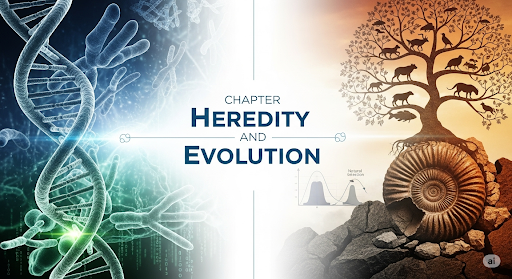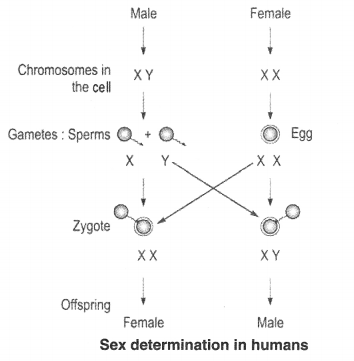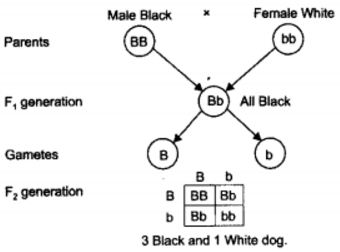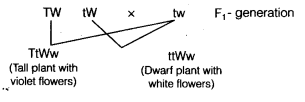Class 10 Science Chapter 9 Heredity and Evolution, explores the fascinating principles of inheritance and the process of evolution. It explains how traits are passed from one generation to the next through genes, the role of DNA, and how variations arise in living organisms.

The chapter also connects heredity with Darwin’s theory of natural selection, helping students understand how species evolve over time. This foundational knowledge is key to understanding biology, genetics, and the diversity of life on Earth.
Page Number: 143
Question 1.
If a trait A exists in 10% of a population of an asexually reproducing species and a trait B exists in 60% of the same population, which trait is likely to have arisen earlier ?
Answer:
Trait B, because it is present in more members of the population. It is likely to have arisen earlier and has now spread to 60% of the population. Trait A is new and has spread to only 10% of the population.
Question 2.
How does the creation of variations in a species promote survival ?
Answer:
The variations provide stability to the population of various species by preventing them from getting wiped out during adverse conditions.
The natural environment also changes, and variations in species which become suited to the environment help it to survive.
Page Number: 147
Question 1.
How do Mendel’s experiments show that traits may be dominant or recessive ?
Answer:
Mendel took pea plants with contrasting characteristics tall plant and dwarf (or short) plant. On cross pollination, he got all tall plants in first generation (F1). But by the self¬pollination of F1 tall plants, the plants of second generation consisted of tall and short pants in the ratio of 3 : 1. On the basis of these experiments, the characteristics appeared in first generation were called dominant (i.e. tall plants) and the characteristics that did not appear were called recessive (dwarf i.e. plants).
Question 2.
How do Mendel’s experiments show that traits are inherited independently ?
Answer:
Mendel took two pairs of alternate expression of two traits and carried out dihybrid crosses by crossing them. The traits appeared in first generation were termed as dominant. When he used these F1 progeny to generate F2 progeny by self-pollination plants of different types were produced. In some plants both the traits were dominant, while in some plants both were recessive and some plants exhibited mixed traits. This indicates that traits are inherited independently.
Question 3.
A man with blood group A marries a woman with blood group O and their daughter has blood group O. Is this information enough to tell you which of the traits – blood group A or O – is dominant ? Why or why not ?
Answer:
This information is not enough. This is because each individual is carrying two alleles. The recessive trait can occur only when who alleles are similar. It blood group A is dominant and O is recessive, then daughter can have blood group O only when both recessive alleles occur together in mother, and father has one allele of O and other of A.
Question 4.
How is the sex of the child determined in human beings ?
OR
“The sex of a newborn child is a matter of chance and none of the parents may be considered responsible for it.” Justify this statement with the help of a flow chart showing determination of sex of a newborn.
Answer:
Half of the male gametes (sperms) carry X chromosome and other half carry Y chromosomes. All the female gametes carry only X chromosomes. When a sperm fertilizes an egg, the following situations become possible.
- (i) When a sperm carrying X chromosome fertilises an egg that contains only X chromosome), the resulting zygote develops into a female (XX condition).
- (ii) When a sperm carrying Y chromosome fertilises an egg (that contains only X chromosome), the resulting zygote develops into a male (XY condition).
Thus there are 50 – 50 chances of a male or female child and none of the parents may Sex determination in humans be considered responsible for it.
The sex-determination mechanism is shown alongside.
Page Number: 150
Question 1.
What are the different ways in which individuals with a particular trait may increase in a population ?
Answer:
Different ways in which individuals with a particular trait may increase in a population are as follow :
- If it gives the benefit of survival through natural selection.
- Due to a sudden increase in a particular trait in a population, i.e., by genetic drift.
Question 2.
Why are traits acquired during the life-time of an individual not inherited ?
Answer:
The traits acquired during the life-time are changes in the non-reproductive cells of the organisms and are not capable of being passed on to the next generation.
Question 3.
Why are the small numbers of surviving tigers a cause of worry from the point of view of genetics ?
Answer:
The small numbers of surviving tigers are a cause of worry from the point of view of genetics because in tigers there are negligible genetic variations. Due to this they are not well adapted. The rapid environmental changes cannot be favouable for them. If these changes are not controlled, tigers would be wiped out.
Page Number: 151
Question 1.
What factors would lead to the rise of a new species ?
Answer:
The factors that would lead to the rise of a new species are the following :
- Geographical isolation of a population caused by various types of barriers (such as mountain ranges, rivers and sea). The geographical isolation leads to reproductive isolation due to which there is no flow of genes between separated groups of pupulation.
- Genetic drift caused by drastic changes in the frequencies of particular genes by chance alone.
- Variations caused in individuals due to a natural selection.
Question 2.
Will geographical isolation be a major factor in the speciation of a self- pollinating plant species ? Why or why not ?
Answer:
The geographical isolation cannot be major factor in the speciation of a self-pollinating plant species because it does not have to look the plants for its process of reproduction to be carried out.
Question 3.
Will geographical isolation be a major factor in the speciation of an organism that reproduces asexually ? Why or why not ?
Answer:
Geographical isolation cannot be a major factor in the speciation of an asexually reproducing organism because it does not require any other organism to carry out reproduction.
Page Number: 156
Question 1.
Give an example of characteristics being used to determine how close two species are in evolutionary terms.
Answer:
If similar characteristics are shown in different organisms, then these are considered to be inherited from the common ancestry. It also shows the closeness of the species.
For example, bats and birds have some similarity in their wings, so they are closely related, while lizard and squirrel do not have wings so these are not closely related to the birds and bats.
Question 2.
Can the wing of a butterfly and the wing of a bat be considered homologous organs ? Why or why not ?
Answer:
The wings of a butterfly and the wings of a bat cannot be considered to be homologous organs because they have different basic designs though they are used for the same purpose of flying. They are analogous organs.5
Question 3.
What are fossils ? What do they tell us about the process of evolution ?
Answer:
Fossils : Fossils are the remains or traces of a dead organism. These are formed through the formation of sedimentary rocks. They provide following information on the process of evolution.
- They tell about the changes that occured on the earth’s surface and the corresponding organisms.
- They tell about the gradual development of complex structured organisms from simple structured organisms.
- It is known through them that birds are evolved from reptiles.
- They state that angiosperms are developed from pteriodophytes and gymnosperms.
- They exhibit the process of humana evolution.
Page Number: 158
Question 1.
Why are human beings who look so different from each other in terms of size, colour and looks said to belong to the same species ?
Answer:
This is because although genetic make up of humans may be slightly different in different races of people, there is no reproductive isolation. Reproductive isolation differentiates one species from the other. Human beings different in size, colour and looks can marry among themselves and produce fertile offspring.
Question 2.
In evolutionary terms, can we say which among bacteria, spiders, fish and chimpanzees have a ‘better’ body design ? Why or why not ?
Answer:
Bacteria is a primitive organism as they came into being very early in evolution. But these organisms are still surviving in the present conditions after millions of years. This is because they have adapted well to the changing environment over these years. Same is the case for all other organisms like spiders, fishes and chimpanzees which have adapted to their environment and have survived. Therefore, all the organisms which exist have a body design which is better as it is suited to their environment.
Page 159 | Class 10 Science Chapter 9 Heredity and Evolution
Question 1.
A Mendelian experiment consisted of breeding tall pea plants bearing violet flowers with short pea plants bearing whfte flowers. The progeny all bore violet flowers, but almost half of them are short. This suggests that the genetic make-up of the tall parent can be depicted as
(a) TTWW
(b) TTww
(c) TtWW
(d) TtWw
Answer:
(c) Genetic make-up of tall plant can be depicted by TtWW.
Question 2.
An example of homologous organs is
(a) our arm and a dogs fore-leg.
(b) our teeth and an elephants tusks.
(c) potato and runners of grass.
(d) All of the above.
Answer:
(d) Both organs in all options have same basic structural design but have different functions and appearance.
Question 3.
In evolutionary terms, we have more in common with
(a) a Chinese school-boy.
(b) a chimpanzee.
(c) a spider.
(d) a bacterium.
Answer:
(a) A Chinese school-bpy is also a human being.
Question 4.
A study found that children with light-coloured eyes are likely to have parents with light-coloured eyes. On this basis, can we say anything about whether the light eye colour trait is dominant or recessive? Why or why not?
Answer:
We can say that light eye colour trait is dominant because only dominant traits are expressed in the first generation.
Question 5.
How are the areas of study – evolution and classification— inteilinked?
Answer:
Evolution and classification are interlinked with each other in many ways. Classification is the most important term to explain evolution. It is based on the similarities and differences between two species or among two organisms. More closer the characteristics, the moe doser is the evolution and chances to be in the same group of classification. Thus, the classification of species is a reflection of their evolutionary relationship.
Question 6.
Explain the terms analogous and homologous organs with examples.
Answer:
Analogous organs are those organs which have different basic structural designs and developmental origins but have similar appearance and perform similar functions.
Examples:
Wings of an insect and wings of a bat.
Homologous organs are those organs which have the same basic structural design and developmenta’ origin but have different functions and appearance.
Examples: Forelimbs of frog and forelimbs of human.
Question 7.
Outline a project which alms to find the dominant coat colour in dogs.
Answer:
A homozygous black (RB) male dog and a homozygous white (bb) female dog is taken and given to mate and produce offspring in F1 generation. If black colour is dominant out of every 4 dogs, 3 will be black and if white colour is dominant 3 out of 4 dogs will be white.
Question 8.
Explain the importance of fossils in deciding evolutionary relationships.
Answer:
Fossils and their study is useful to know about the species which are no longer alive. They provide evidence and missing links between two classes. They are helpful in forming a sequence of organisms in the pathway of evolution. Thus, fossils have importance in deciding evolutionary relationships.
Question 9.
What evidence do we have for the origin of life from inanimate matter?
Answer:
Stanley L. Miller and Harold C. Urey provided evidence regarding origin of life from inanimate matter. They assembled an atmosphere similar to that existed on early earth. The atmosphere had molecules like ammonia, methane, hydrogen sulphide and water, but no oxygen. The mixture was maintained at a temperature just below 100◦C and sparks were passed through the mixture of gases. At the end of a week, 15% carbon from methane had been converted to simple compounds of carbon like aminoacids which make up protein molecules. So, life arose afresh on earth.
Question 10.
Explain how sexual reproduction gives rise to more viable variations that asexual reproduction. How does this affect the evolution of those organisms that reproduce sexually ?
Answer:
Variations occurring during sexual reproduction may be due to:
- Separation of homologous chromosomes (by chance only) during gamete formation.
- Crossing over (recombination) of homologous chromosomes.
- Fertilisation of gametes to form zygote.
- Errors during DNA copying or mutations.
In asexually reproducing organisms only errors during DNA copying or mutations cause variations.
Since the extent of variations is much larger in sexually reproducing organisms, therefore, the chances of evolution is also much in sexually reproducing These variations enable the organisms to adapt themselves to the changing conditions and also help to face the struggle for Over the time, they and rise to new species.
Question 11.
How is the equal genetic contribution of male and female parents ensured in the progeny?
Answer:
Genetically organisms are of types
(i) Haploid : They have single set of chromosomes, where each chromosome is represented singly. As the chromosomes are the bearer of genes so haploids have single set of genes. A single gene determines the expression of character.
(ii) Diploid : ‘They have two sets Of homologous chromosomes, where the chromosome occur in pair, one maternal contributed by the mother through her ovum and the second Of the pair is contributed by the male parent through his sperm. The resultant cell zygote produces by the fusion of male and female gametes have two sets of chromosomes – each set contributed’ by each parent. In diploids a character is controlled by two genes/factors. Both the father and mother contribute practically equal amount of genetic material to the child. It means that each trait can be influenced by both paternal and maternal DNA.
Question 12.
Only variations that confer an advantage to an individual organism will survive in a population. Do you agree with this statement ? Why or why not ?
Answer:
No, many of the times the variations are not advantageous to an individual organism but still survive in a population, e.g., take the case of free ear lobe and attached ear lobe. Most of the other variations not only give survival advantage to an individual but also contribute to genetic drift. Thus, we can say that most of the variations lead to better adaptation of an organism to the changing environment. In this way, it gives survival advantage to that organism and will also survive in the coming population.
Multiple Choice Questions (MCQs) [1 Mark each]
Question 1.
An example of homologous organs is [NCERT]
(a) our arm and a dog’s foreleg
(b) our teeth and an elephant’s tusks
(c) potato and runners of grass
(d) All of the above
Answer:
(a) Our arm and a dog’s foreleg is the example of homologous organs.
Question 2.
The science, which deals with study of heredity and variations is called
(a) phylogeny
(b) embryology
(c) genetics
(d) palaeontology
Answer:
(c) The genetics is the study of heredity and variations and includes their occurrence, causes, benefits, disadvantages, significance, etc.
Question 3.
Archaeopteryx is a connecting link between
(a) reptiles and aquatic animals
(b) birds and insects
(c) reptiles and birds
(d) birds and dinosaurs
Answer:
(c) Archaeopteryx is a connecting link- between the reptiles and birds. It appears like a bird, but has other features which are present in reptiles, e.g. it has wings like bird, but teeth and tail like the reptilians.
Question 4.
For palaeontological studies a scientist will gather the evidences from
(a) study of homology
(b) study of analogy
(c) fossils
(d) All of these
Answer:
(d) Study of homologous and analogous organs indicates the origin and modification in organisms and study of fossils indicates the age and features of an organism.
Question 5.
In evolutionary terms, we have more in common with
(a) a Chinese school boy
(b) a chimpanzee
(c) a spider
(d) a bacterium
Answer:
(a) Chinese school boy because both of us belong to the same species, i.e. Homo sapiens.
Question 6.
Aditya was observing some organisms in lab and tried to compare them. The presence of which organs will confirm to him that they share evolutionary history?
(a) Analogous organs
(b) Paralogous organs
(c) Homologous organs
(d) None of these
Answer:
(c) Homologous organs are present in organisms who share evolutionary history. However, these organs perform different functions in different organisms.
Question 7.
New species may be formed if
I. DNA undergoes significant changes in germ cells. .
II. chromosome number changes in the gamete.
III. there is no change in the genetic material.
IV. mating does not take place.
(a) I and II
(b) I and III
(c) II, III and IV
(d) I, II and III
Answer:
(a) New species may be formed if the DNA changes are severe enough, such as a change in the number of chromosome. This leads to new variations.
Question 8.
Which of the following statements is not true with respect to variation?
(a) All variations in a species have equal chance of survival.
(b) Change in genetic composition results in variation.
(c) Selection of variants by environmental factors forms the basis of evolutionary processes.
(d) Variation is minimum in asexual reproduction.
Answer:
(a) All variations in a species do not have equal chances of survival. Some of the variations may be so drastic that the new DNA copy cannot work with the cellular apparatus it inherits. Such, a newborn cell dies soon.
Question 9.
Select the statement that describes characteristics of genes. .
(a) Genes are specific sequence of bases in a DNA molecule.
(b) A gene does not code for proteins.
(c) In individuals of a given species, a specific gene is located on a particular chromosome.
(d) Each chromosome has only one gene.
Answer:
(b) Genes are stretches of DNA found on chromosomes of a cell. A gene contains information for making proteins in a cell. A specific gene is located on a particular chromosome in individuals of a given species.
Question 10.
If a round, green seeded pea plant (RRyy) is crossed with wrinkled, yellow seeded pea plant (rrYY), the seeds produced in F1 – generation will be
(a) round and yellow
(b) round and green
(c) wrinkled and green
(d) wrinkled and yellow
Answer:
(a) The cross between RRyy and rrYY seeds will produce RrYy (round and yellow) seeds in F1-generation, because round and yellow are the dominant traits.
Question 11.
From the list given below, select the character, which can be acquired but not inherited. [NCERT Exemplar]
(a) colour of eye
(b) colour of skin
(c) size of body
(d) nature of hair
Answer:
(c) Acquired traits develop in response to the environment. The size of the body is an acquired trait because it can vary based on the availability of less or more food. The other three colour of eye and skin and nature of hair are characters inherited from the parents.
Question 12.
According to the evolutionary theory, formation of a new species is generally due to [NCERT Exemplar]
(a) sudden creation by nature.
(b) accumulation of variations over several generations.
(c) clones formed during asexual reproduction.
(d) movement of individuals from one habitat to another
Answer:
(b) Accumulation of variations over several generations forms new species. Genetic drift accumulates different changes in sub-populations of a species. Also, natural selection may also operate differendy in the different geographic locations. Eventually, different groups of new species will be formed.
Question 13.
Select the incorrect statement.
(a) Frequency of certain genes in a population changes over several generations resulting in evolution.
(b) Reduction in weight of the organism due to starvation is genetically controlled.
(c) Low weight parents can have heavy weight progeny.
(d) Traits which are not inherited over generations do not cause evolution.
Answer:
(b) The weight reduction due to starvation will not change the DNA of the germ cells, because low weight is not a trait that is genetically controlled or inherited. Also, low weight parents may have heavy weight progeny.
Question 14.
In human males all the chromosomes are paired perfectly except one. This/these unpaired chromosome is/are
I. large chromosome
II. small chromosome
III. Y-chromosome IV X-chromosome
(a) I and II
(b) Only III
(c) III and IV
(d) II and IV
Answer:
(c) In human males, one pair called the sex chromosomes are unpaired. Here, one is a normal-sized X-chromosome while other is a short Y-chromosome. Women have a perfect pair of sex chromosomes, both called X.
Question 15.
Rajneesh was studying the fossils of two different types, fossil A was found in upper layer of Earth and B in deeper layers. What can be predicted regarding the age of these fossils?
(a) A has recently become extinct
(b) B has become extinct recently
(c) The time of extinction cannot be determined
(d) None of the above
Answer:
(a) Since, fossil A was found in upper layer of earth, it suggests that the organism has become extinct recently. Fossil B found in deeper layer must have become extinct long time ago and deposition of other layers occurred over it during this period.
Question 16.
A Mendelian experiment consisted of breeding tall pea plants bearing violet flowers with short pea plants bearing white flowers. The progeny all bore violet flowers, but almost half of them were short. This suggests that the genetic makeup of the tall parents can be depicted as [NCERT]
(a) TTWW
(b) TTww
(c) TtWW
(d) TtWw
Answer:
(c) Parent with genotype TtWW produce two types of gametes TW and tW, while the other with genotype ttww produce only one type of gamete W.
📘 Math & Science Solutions by Class
🔹 Class 10
🔹 Class 9
🔹 Class 8
🔹 Class 7
🔹 Class 6
🔹 Class 12
🔹 Class 11
- Class 11 Math Solutions
- Class 11 Physics Solutions
- Class 11 Chemistry Solutions
- Class 11 Biology Solutions
Access the NCERT Textbook:
- NCERT Official Website: Visit the NCERT website
This chapter covers essential topics such as Mendel’s laws of inheritance, the role of DNA in heredity, and the evidence supporting the theory of evolution. It’s a valuable resource for understanding the genetic mechanisms that drive biological diversity.
